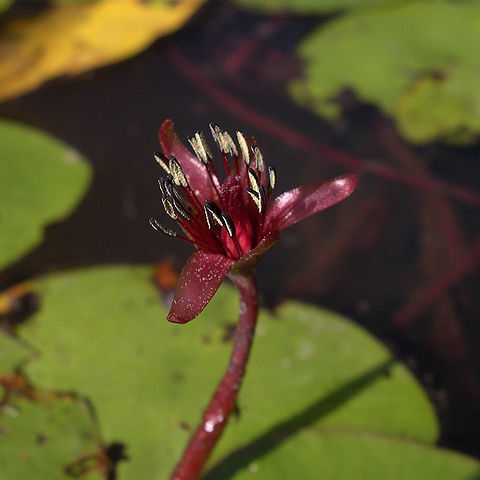Herbs , young vegetative parts heavily coated with mucilage. Leaves floating; petiole long. Leaf blade elliptic. Flowers: sepals 3, not petaloid, linear-oblong to narrowly ovate; petals 3, linear-oblong, lacking auricles, base not clawed; stamens 18-36(-51), opposite both sepals and petals; pistils 4-18, simple, 1-locular; ovules (1-)2; stigma linear-decurrent. Fruits slightly to strongly fusiform. Seeds ovoid, tubercles absent. x = 40.
Herbs, rooting from nodes of stolons and lower stems, with floating leaves. Submerged leaves absent. Floating leaves alternate, long-petiolate; lamina peltate, orbicular to elliptic, entire. Flowers purplish red or brownish red. Sepals 3, rarely 2 or 4, petaloid. Petals 3, rarely 2 or 4, linear, sessile. Stamens 12–36 or more; filament filiform. Carpels 4–18, free, each with 2 pendulous ovules. Seeds smooth or papillate.
Sep somewhat petaloid, colored within; stamens 12–18, or reputedly to 36; filaments of 2 lengths; anthers introrse, pistils 4–8; submerged parts covered with a mucilaginous jelly; lvs alternate, mostly crowded near the summit, long-petioled, with floating, centrally peltate blade. Monospecific
Floating leaves peltate; submerged leaves absent. Sepals and petals persistent in fruit. Stamens 12–18. Carpels 6–18. Testa with cells of outer layer very characteristically elongated radially.
Leaves floating and peltate, submerged dissected leaves lacking.
Stamens 12–18.
Carpels 6–18.

